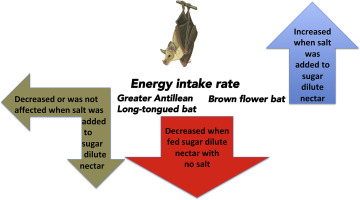当前位置:
X-MOL 学术
›
Comp. Biochem. Physiol. A Mol. Integr. Physiol.
›
论文详情
Our official English website, www.x-mol.net, welcomes your feedback! (Note: you will need to create a separate account there.)
Salt has contrasting effects on the digestive processing of dilute nectar by two Neotropical nectarivorous bats.
Comparative Biochemistry and Physiology A: Molecular & Integrative Physiology ( IF 2.3 ) Pub Date : 2019-11-18 , DOI: 10.1016/j.cbpa.2019.110619 L Gerardo Herrera M 1 , Beatriz F Esnard H 2 , L Margarita Sánchez 3 , Carlos A Mancina G 4
Comparative Biochemistry and Physiology A: Molecular & Integrative Physiology ( IF 2.3 ) Pub Date : 2019-11-18 , DOI: 10.1016/j.cbpa.2019.110619 L Gerardo Herrera M 1 , Beatriz F Esnard H 2 , L Margarita Sánchez 3 , Carlos A Mancina G 4
Affiliation

|
Nectarivorous vertebrates might include sugar-dilute nectar in their diet and they are expected to undergo compensatory feeding. However, physiological constraints might limit the intake of sugar-dilute nectar, affecting energy budgets. Among other physiological processes, the limiting role of osmoregulation is supported by enhanced intake rate of dilute sugar solutions by avian nectarivores when salt is added. We tested if the Greater Antillean Long-tongued bat (Monophyllus redmani) and the Brown flower bat (Erophylla sezekorni) compensated energy intake when fed dilute-sugar solutions (2.5 and 5% sucrose), and if salt content (11, 20 and 40 mM NaCl l-1) modulated the intake rate of these solutions. Both species were unable to compensate intake of solutions with varying sugar densities, and energy intake on the 2.5 and 5% diets was lower than on the most concentrated diets (10, 20 and 30% sucrose). Both species responded differently to the addition of salt. Salt addition did not affect the intake of 2.5% sugar solutions by the Greater Antillean Long-tongued bat, and it decreased the intake of 5% sugar solutions. In contrast, the Brown flower bat increased the intake of 2.5 and 5% sugar solutions when salt was added. Intake responses to varying sugar densities of our two focal species and that of other bat species previously studied indicate that they are not uniform and that they might be modulated by digestive and osmoregulatory physiological traits.
中文翻译:

盐对两个新热带肉食蝙蝠在稀花蜜的消化过程中具有相反的作用。
食肉脊椎动物的饮食中可能包括糖稀释的花蜜,预计它们将进行补偿性摄食。但是,生理上的限制可能会限制糖稀释的花蜜的摄入,从而影响能量预算。除其他生理过程外,当添加盐时,禽油桃提高了稀糖溶液的摄取速率,也支持了渗透调节作用的局限性。我们测试了在饲喂稀糖溶液(2.5和5%蔗糖)时,大安蒂尔良长舌蝠(Monophyllus redmani)和棕花蝙蝠(Erophylla sezekorni)是否能补偿能量摄入,以及盐含量(11、20和40) mM NaCl 1-1)调节了这些溶液的摄入速率。两种物种都无法补偿糖密度不同的溶液的摄入量以及2种能量的摄入量。5%和5%的饮食比最集中的饮食(10%,20%和30%的蔗糖)低。两种物种对添加盐的反应都不同。加盐不会影响大安蒂尔长舌蝙蝠对2.5%糖溶液的摄入,并且会减少5%糖溶液的摄入。相反,当添加盐时,棕色花蝙蝠增加了2.5和5%糖溶液的摄入量。两种研究对象以及先前研究的其他蝙蝠物种对不同糖密度的摄入响应表明,它们的摄入量不均匀,并且可能受到消化和渗透调节生理特性的调节。较大的安蒂尔长舌蝙蝠使用5%的食糖溶液,从而减少了5%食糖的摄入量。相反,当添加盐时,棕色花蝙蝠增加了2.5和5%糖溶液的摄入量。两种研究对象以及先前研究的其他蝙蝠物种对不同糖密度的摄入响应表明,它们的摄入量不均匀,并且可能受到消化和渗透调节生理特性的调节。较大的安蒂尔长舌蝙蝠使用5%的食糖溶液,从而减少了5%食糖的摄入量。相反,当添加盐时,棕色花蝙蝠增加了2.5和5%糖溶液的摄入量。两种研究对象和先前研究的其他蝙蝠对不同糖密度的摄入反应表明,它们的摄入量不均匀,并且可能受到消化和渗透调节生理特性的调节。
更新日期:2019-11-19
中文翻译:

盐对两个新热带肉食蝙蝠在稀花蜜的消化过程中具有相反的作用。
食肉脊椎动物的饮食中可能包括糖稀释的花蜜,预计它们将进行补偿性摄食。但是,生理上的限制可能会限制糖稀释的花蜜的摄入,从而影响能量预算。除其他生理过程外,当添加盐时,禽油桃提高了稀糖溶液的摄取速率,也支持了渗透调节作用的局限性。我们测试了在饲喂稀糖溶液(2.5和5%蔗糖)时,大安蒂尔良长舌蝠(Monophyllus redmani)和棕花蝙蝠(Erophylla sezekorni)是否能补偿能量摄入,以及盐含量(11、20和40) mM NaCl 1-1)调节了这些溶液的摄入速率。两种物种都无法补偿糖密度不同的溶液的摄入量以及2种能量的摄入量。5%和5%的饮食比最集中的饮食(10%,20%和30%的蔗糖)低。两种物种对添加盐的反应都不同。加盐不会影响大安蒂尔长舌蝙蝠对2.5%糖溶液的摄入,并且会减少5%糖溶液的摄入。相反,当添加盐时,棕色花蝙蝠增加了2.5和5%糖溶液的摄入量。两种研究对象以及先前研究的其他蝙蝠物种对不同糖密度的摄入响应表明,它们的摄入量不均匀,并且可能受到消化和渗透调节生理特性的调节。较大的安蒂尔长舌蝙蝠使用5%的食糖溶液,从而减少了5%食糖的摄入量。相反,当添加盐时,棕色花蝙蝠增加了2.5和5%糖溶液的摄入量。两种研究对象以及先前研究的其他蝙蝠物种对不同糖密度的摄入响应表明,它们的摄入量不均匀,并且可能受到消化和渗透调节生理特性的调节。较大的安蒂尔长舌蝙蝠使用5%的食糖溶液,从而减少了5%食糖的摄入量。相反,当添加盐时,棕色花蝙蝠增加了2.5和5%糖溶液的摄入量。两种研究对象和先前研究的其他蝙蝠对不同糖密度的摄入反应表明,它们的摄入量不均匀,并且可能受到消化和渗透调节生理特性的调节。


























 京公网安备 11010802027423号
京公网安备 11010802027423号